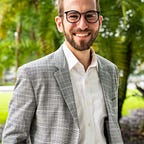My Internet Story
Catch me on Cloudflare.tv with Dan Hollinger on August 3, 2020 to hear more about this story
In between texts sent over t-9 phones, my days at Highland Park Middle School in Beaverton, Oregon from 2006 to 2008 were fairly typical — social studies, science, and math classes filled my schedule, cool kids dominated the lunchroom, and the rest of us did our best to hide our insecurities (which were manifold).
However, I’ve come to learn that at least one part of my middle school education was unique: technology class. It was only a semester-long course but it was easily the most impactful and useful instructional time. Whereas students generally lingered in the halls well past the tardy bell, when the technology class period rolled around everyone was in the computer lab a few minutes early.
In that dark, crowded room, we each were perched in front of our very own computer. Our eyes were glued to the center screen where our teacher, Ms. Miller, readied to introduce us to some new exciting tool. At her direction, we learned everything from how to use boolean search terms to composing our own jingle on GarageBand.
Turns out that most 6th graders, let alone k-12 school students in general, don’t have any formal technology education. Many students don’t even have a device to access at their school. And, even fewer students have Internet and devices to access at home. It follows that my access to technology was a happy accident of having been born in the shadow of Intel, which has a headquarter office in Beaverton. Populated by families of software engineers, my school district prioritized giving students access to every part of the three-legged stool of digital equity: access to Internet, devices, and digital literacy.
Equipped with each leg of the stool, I developed new skills that have stuck with me to today. Technology class fueled a sense of curiosity within me. By showing me how to safely and efficiently navigate the Internet, I was able to open doors to all sorts of opportunities as well as to answer questions that I thought were beyond comprehension.
Case in point, one of my earliest assignments in the class was on tsunamis. Given that I grew up in Oregon, the inevitability of a big wave crashing on our coast was a point of fascination for me…but I never imagined being able to understand exactly how tsunamis formed nor to have the tools to map how a tsunami could endanger communities along the shore. But with a guiding hand from Ms. Miller and the nearly infinite resources available on the Internet, I like to think I became my school’s leading tsunami expert (which isn’t saying much because I was the only one studying them). The ability to ask big questions and find clear answers via the Internet empowered me to keep chasing down information and to perpetually dig deeper and deeper into thorny and complex problems.
I’d venture to guess that my relentless pursuit of answers and comfort using the Internet jointly led me to where I am today — studying technology policy and law as part of a concurrent degree program at the Harvard Kennedy School and UC Berkeley School of Law. Without technology class, I’m not sure I would have pursued such a tech-centric academic and professional path. That’s why I am thrilled to be working for Cloudflare — a company that believes in building a better Internet. That’s also why I spend my free time raising awareness of and funds to help close the Digital Divide through my nonprofit — No One Left Offline (NoOneLeftOffline.org).
So here is to Ms. Miller, the folks at Highland Park Middle School, and the administrators at the Beaverton School District for introducing me to the Internet. And, here is to all the folks working to close the Digital Divide — access to technology should not be a function of your proximity to a tech giant.
